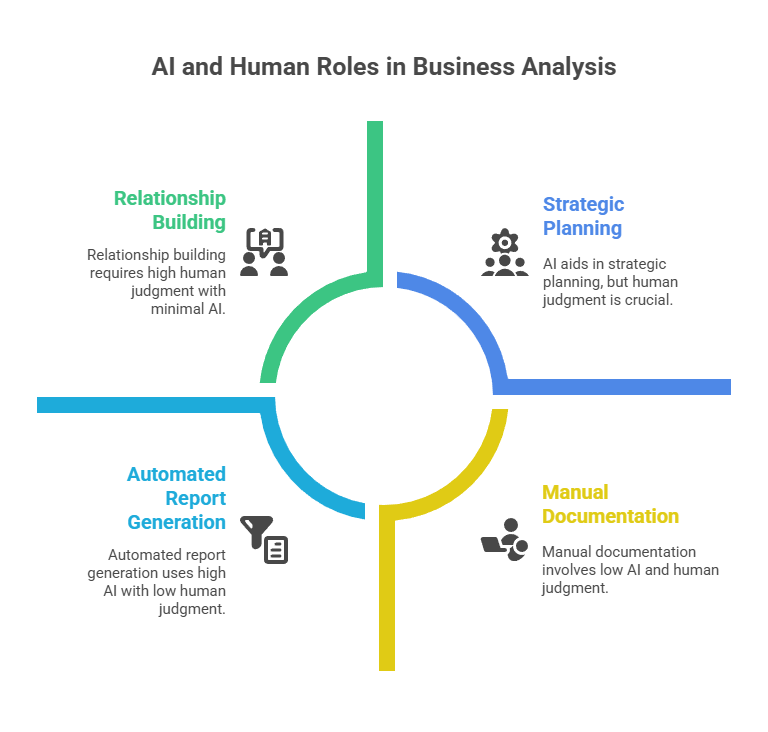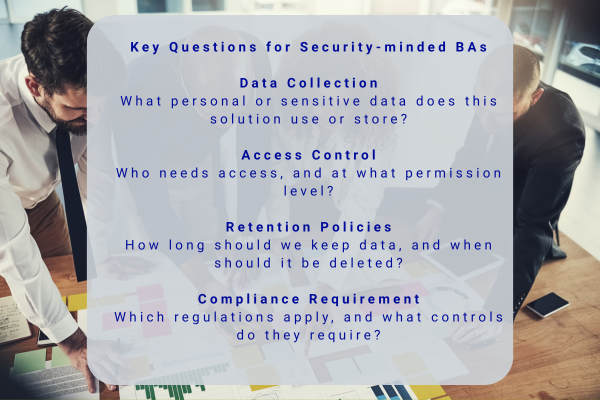Key Takeaways
- Data Fluency Wins: Moving beyond reporting to diagnostic thinking improves decisions.
- AI Partnership Matters: Automation increases impact when balanced with human judgment.
- Influence Drives Adoption: Insights only matter with stakeholder trust.
- Systems Perspective Scales: Seeing connections prevents fixes from becoming new problems.
- Risk Awareness Protects: Early collaboration and secure design prevent costly rework.
- Learning Never Stops: Curiosity and adaptability sustain long-term success.
From Order-Takers to Problem-Shapers
The business analyst (BA) role is constantly evolving. Today’s BAs do more than gather requirements. They bridge business and technology, influence strategy, and guide teams through change. With Global Business Analyst Day on November 14, it’s the perfect time to explore what separates strategic BAs from order-takers.
At SentinelWave, the BA leadership team saw this shift coming. Their analysts had delivered solid work for years, but cloud migrations, AI adoption, and product-based thinking demanded new capabilities. The challenge became deciding where to focus for the greatest impact.
In a recent planning session, the team noticed a pattern. Projects succeeded when BAs translated technical ideas into business value and thought several steps ahead. The analysts who thrived were curious, adaptable, and ready to adjust as conditions changed.
So, what does it take to thrive as a BA in 2026? We’ve identified six essential skill sets that separate strategic translators from order-takers:
- Skill #1: Data Literacy & Analytical Thinking
- Skill #2: AI Collaboration & Automation Insight
- Skill #3: Facilitation & Stakeholder Influence
- Skill #4: Strategic Agility & Systems Thinking
- Skill #5: Security, Risk & Compliance Awareness
- Skill #6: Continuous Learning & Professional Growth
Let’s dive into each one and explore how you can develop these capabilities to future-proof your BA career.
Data Fluency Is Your Edge in 2026
Today’s challenge isn’t finding data but keeping up with how quickly it changes. Modern BAs extract insights from dashboards, interpret trends, and share findings that drive action. True data literacy means asking sharper questions and anticipating which metrics will matter next. A 2023 data-skills report found that around 74% of respondents agreed or strongly agreed that those with data literacy skills outperform those without, and 41% saw inaccurate decision-making as the top risk when data skills are inadequate.
During SentinelWave’s strategic planning session, their senior BA shared a recent experience. “I built a perfect dashboard,” she said, “but executives asked questions I hadn’t anticipated because I focused on the data I had, not the decisions they needed.” The moment underscored that effective analysis starts with business context, not just available data.
The real skill is moving from descriptive reporting to diagnostic analysis. Showing what happened is easy; explaining why it happened and what it means takes insight. Visualization tools help tell the story, but only if you know which story needs telling.
Essential data skills for modern BAs:
- Context First: Understand the business decision before selecting metrics or building reports
- Quality Awareness: Recognize data gaps, inconsistencies, and reliability issues that affect conclusions
- Tool Proficiency: Use visualization platforms like Power BI and Tableau to tell clear stories
- Statistical Thinking: Distinguish correlation from causation and avoid common analysis pitfalls
Data storytelling drives influence. BAs who turn numbers into narrative help leaders see risks and opportunities clearly. The goal isn’t accuracy alone but clarity that enables confident decisions. As AI expands, guiding those insights will matter even more.
Partner with AI to Work Smarter
Anxiety about AI replacing BAs misses the point. The real question is how BAs will use it to extend their impact. Generative AI now drafts requirements, summarizes interviews, and automates documentation, freeing analysts to focus on higher-value work.
The VP of Products shared what happened in a recent internal trial. “Two BAs worked on similar projects,” he said. “One used AI, and the other did not. The AI-assisted BA finished faster and used the time for extra validation sessions that caught major gaps.” The results highlighted that the real advantage wasn’t speed, but the opportunity for deeper analysis and better decisions.
AI tools recognize patterns but miss nuance. They can’t read politics or priorities. Smart analysts treat AI as a partner, not an adversary. They use automation for speed and rely on human judgment for accuracy and trust.
How to work smarter with AI:
- Automate Documentation: Let AI handle meeting transcripts, draft stories, and templates
- Validate Everything: Check AI outputs for accuracy, context, and relevance
- Focus on Judgment: Use saved time for validation, relationships, and strategy
- Understand Limits: AI can’t read politics or unspoken concerns
Thriving BAs in 2026 won’t resist AI. They’ll embrace it. They will use it to handle routine work, allowing them to focus on analysis and problem-solving. While AI can handle repetitive tasks, it can’t replicate the people skills that drive collaboration and results. Those connections give BAs the influence technology alone can’t deliver.

The Power of Influence to Get Results
Technical skills show what you know, but influence shows how you lead. The best requirements document means little if people aren’t aligned behind it. Certifications validate expertise, but facilitation turns it into meaningful progress.
As the discussion turned to leadership skills, the CIO shared an example that stood out. “Our lead BA helped engineering and sales finally hear each other,” he said. The takeaway was clear: influence isn’t about control but about creating the conditions for collaboration.
Facilitation isn’t just about running meetings or gathering input. It’s about creating trust so people share what really matters. Skilled BAs read the room, manage tension, and help teams find common ground, even when half the group joins remotely.
Building influence across the organization:
- Speak Their Language: Link ideas to what stakeholders value most
- Build Credibility: Keep promises and follow through consistently
- Read the Room: Know what drives people and adjust your approach
- Think Executive-Level: Tie technical work to business outcomes
Influence isn’t manipulation or politics in a negative sense. It’s understanding what matters to each stakeholder and earning trust through reliability. That same awareness of people’s needs also helps BAs see how processes, systems, and teams connect, skills that become critical in complex environments.
The Advantage of Seeing the Big Picture
Projects are more complex and connected than ever. Requirements link to systems and processes that often stay hidden until something breaks. Systems thinking means spotting those links early and understanding how one change affects the whole.
The process lead added her perspective with a recent example. “When we improved our approval process,” she said, “we didn’t just make one step faster. We removed handoffs that slowed everything down.” It was a clear reminder that strong process work depends on understanding how each part affects the whole.
As organizations blend project-based delivery with product-based strategy, systems awareness becomes essential. Projects may end, but products and processes continue to evolve. BAs must look beyond short-term deliverables and help teams design solutions that stay effective as needs change.
Systems thinking in practice:
- Map Dependencies: Identify how one change affects other processes and systems
- Embrace Product Mindset: Evolve solutions instead of treating them as one-time deliverables
- Understand Value Streams: See where work moves smoothly and where it stalls
- Apply Agile Thoughtfully: Use planning and refinement to reveal hidden complexity
BAs who think in systems don’t just connect dots — they anticipate how today’s change will shape tomorrow’s performance. That perspective naturally leads to the next skill: managing risk and ensuring compliance from the start.
Build Smart with Security in Mind
Cybersecurity is no longer someone else’s problem. With frequent breaches and tighter regulations, every BA must think about risk from the start.
Those risks now extend beyond privacy and access. AI introduces new challenges like bias, transparency, and unclear decision logic. BAs don’t need to be security experts, but they do need to ask the right questions and involve the right people early.
The CISO added to the discussion with a security perspective. “We started including security in kickoff meetings,” he said. “It added 30 minutes up front but saved weeks of rework.” The example reinforced how early collaboration reduces risk and builds confidence across teams.
Most projects now face strict privacy requirements. Frameworks like GDPR, CCPA, and industry-specific standards shape what can be built and how. Knowing which questions to ask early helps BAs capture security needs alongside functional ones.

Security awareness is as much about mindset as it’s about knowledge. BAs who stay alert to technical, ethical, and procedural risks help their organizations make smarter decisions. That same curiosity and adaptability also drive continuous learning, which keeps BAs ready for whatever comes next.
Stay Curious, Continue Learning, Keep Leading
Change moves fast, and what matters today can become routine or outdated by next year. Continuous learning isn’t just about collecting certifications; it’s about staying curious and adaptable so you’re ready for whatever your next project demands.
During the final moments of the discussion, SentinelWave’s lead BA reflected on how professional connections shaped her growth. “Someone else’s challenge today might be mine tomorrow,” she said. The comment brought the conversation full circle, highlighting how curiosity and shared learning drive lasting growth.
Structured learning still matters. Certifications like CBAP, PMI-PBA, and agile credentials build credibility. But the BAs who stay relevant also learn through experimentation, cross-functional work, and smart risk-taking on new projects.
Ways to expand your capabilities:
- Cross-Train Strategically: Learn UX for design work and basic data science for analytics
- Join Professional Communities: Attend IIBA chapters and conferences to stay ahead of challenges
- Build Your Network: Peer connections often offer as much value as formal training
- Strengthen Fundamentals: Time management and critical thinking keep skills sharp under pressure
Continuous learning links every BA capability. Curiosity sharpens skills, and collaboration turns knowledge into real progress that strengthens both individual growth and organizational success. When BAs commit to learning as a daily habit, they don’t just adapt to change; they help lead through it.
Become the BA Your Team Needs
The BA role continues to evolve quickly. Organizations now look for professionals who connect strategy and technology rather than just gather requirements. The six skills we’ve covered aren’t optional anymore: they’re the foundation for staying relevant and making an impact.
Ten months after the planning session, SentinelWave’s BA team had clear results. Project success rates rose 30 percent, and executives began pulling analysts into strategy discussions earlier. The team shifted from order-takers to problem-shapers, helping leaders decide which challenges deserved attention.
That growth changed the culture, too. Junior analysts gained confidence, senior BAs focused on strategy, and cross-functional teams worked more effectively. What began as a skills initiative became a catalyst for broader organizational progress.
As we celebrate Global Business Analyst Day, take this as your cue to invest in yourself. You don’t need to master every skill at once; choose one area to grow and commit to it. The future belongs to analysts who keep learning and helping their organizations move forward. Those who evolve from order-takers to problem-shapers will define the future of business analysis itself.
Ready to strengthen your 2026 BA skill set? Explore Watermark Learning’s Business Analysis courses and see how integrated training in leadership, process, and technology can accelerate your career growth.
Jay Pugh, PhD
Dr. Jay Pugh is an award-winning leader, author, and facilitator with over 18 years of teaching and training experience. Currently serving as Head of Leadership Growth at Educate 360, he leads a robust team of external and internal facilitators who specialize in developing leadership capabilities within medium and large-scale businesses. His team works directly with business professionals, helping them become more effective leaders in their daily operations.
Dr. Pugh holds a Ph.D. in Instructional Management and Leadership, and his academic contributions include two published articles and a dissertation focusing on various educational topics. His extensive experience and academic background have established him as a respected voice in leadership development and educational management.

 New Horizons
New Horizons
 Project Management Academy
Project Management Academy
 Six Sigma Online
Six Sigma Online
 Velopi
Velopi
 Watermark Learning
Watermark Learning
 Login
Login





 New Horizons
New Horizons
 Project Management Academy
Project Management Academy
 Velopi
Velopi
 Six Sigma Online
Six Sigma Online
 Watermark Learning
Watermark Learning